Stay tuned for weekly sun activity reports as the monthly sun archive gets updated throughout September. To view the most recent updates on sun activity, visit our daily sun post!
Sun news September 15: Strong X flare and fast eruption!
An X4.5 flare erupted late yesterday (around 15:29 UTC on September 14) from the new kid on the block, sunspot region AR3825. This region has just rotated onto the Earth-facing solar disk. The event released a fast CME, a burp of sun-stuff that – combined with an earlier M1 flare from over the sun’s southeat limb – should reach Earth on September 16. In other words, yesterday’s fast CME will overtake the slower one, becoming what’s called a cannibal CME. Meanwhile, on Earth, we’ve had half a week or so of geomagnetic storming. And the arrival of the September 13 and September 14 CMEs are likely to increase conditions to G3 (strong) storm levels. Combined CME/coronal hole effects should persist into September 17, giving us G2 (moderate) geomagnetic storm conditions (probably). Stay tuned for more.
Last 24 hours: Sun activity is high, thanks to the X4.5 flare – the day’s largest flare – at 15:29 UTC on September 14 from sunspot region AR3825. It caused an R3 (strong) radio blackout affecting an area over Eastern South America. Otherwise, we saw only C flares during our observation period (11 UTC yesterday to 11 UTC today). The X flare made AR3825 lead flare producer; it had six flares in all, the X and five C flares. Two large coronal holes are now in a geoeffective position. Earth should start receiving fast solar wind beginning tomorrow, September 15. Bring it on, auroras!
X flare!!! ???Excitement on the ?!! X4.5 flare around 15:28 UTC from the new kid on the block AR3825 and there appears to be an eruption of stuff. Anything coming our way? Waiting to find out
MORE later at https://t.co/xD29wLfm4e pic.twitter.com/xcHbUfxf23— Dr. C. Alex Young (@TheSunToday) September 14, 2024
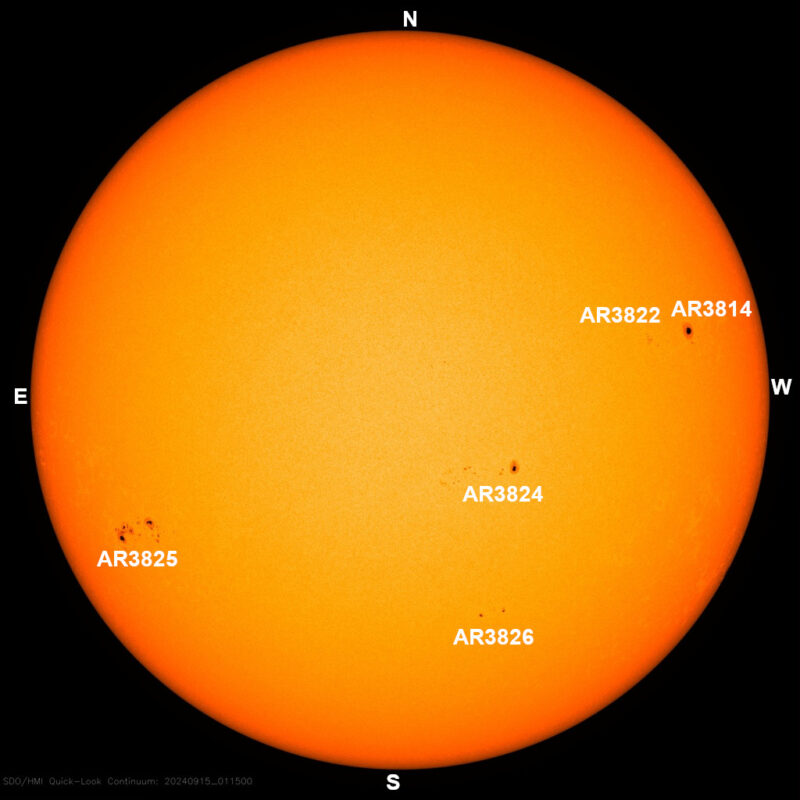
Sun news update September 14: X Flare! Excitement on the sun
UPDATE. An X4.5 flare erupted following the end of our usual observation period at 15:28 UTC on September 14. It came from the new kid on the block, AR3825. Stay tuned to see if sun stuff will be heading our way.
Coronal mass ejections (CMEs) – or explosions of sun stuff – just keep coming. And they aren’t just heading toward Earth. One launched from the side of the sun yesterday is headed straight at Mercury and its orbiting spacecraft, BepiColombo. The CME may also make a glancing blow at Mars. At Earth, the expected geomagnetic storming from a CME arrived late yesterday and earlier today. We expected a G1 (minor) geomagnetic storm, but the storm reached G2 (moderate) levels. The geomagnetic storming hit the Kp = 6 threshold at 22:44 UTC on September 13 and lasted for a three-hour period last night in the U.S. and Canada. Auroral displays would have been possible as far south as Montana and Washington and the boundary of northern Wyoming. Did you see the auroras? Share those beautiful photos with us.
Last 24 hours: Our star returned to moderate solar activity with four small M flares over the past day. Flaring production also decreased to nine flares compared to yesterday’s 19 flares. The sun produced the four M and five C flares, all occurring during our observation period between 11 UTC yesterday to 11 UTC today. The largest flare of the day was an M3.0 flare at 7:41 UTC on September 14 from active region AR3825 in the southeast. It caused an R1 (minor) radio blackout affecting an area over the Arabian Sea, west of the Maldives. The lead flare producer was active region AR3825 with six flares, three M and three C flares. The list of the M flares is:
• M1.3 at 15:12 UTC on September 13 from AR3811. R1 (minor) radio blackout over the Atlantic Ocean off the north coast of Brazil.
• M1.4 at 17:56 UTC on September 13 from behind the SE limb. R1 (minor) radio blackout over the Pacific Ocean off the west coast of Colombia.
• M1.1 at 20:49 UTC on September 13 from behind the SE limb. R1 (minor) radio blackout over the Pacific Ocean southeast of Hawaii.
• M3.0 at 7:41 UTC on September 14 from AR3825. R1 (minor) radio blackout over the Arabian Sea, west of the Maldives.
The sun has six labeled active regions. Most of the numbered active regions on the solar disk decayed to an alpha or beta configuration, but yesterday’s newcomer on the southeast limb (edge), AR3825, has an interesting beta-gamma-delta magnetic complexity. Two large coronal holes are now in a geoeffective position. Earth should start receiving fast solar wind beginning tomorrow, September 15. Bring ’em on, auroras!
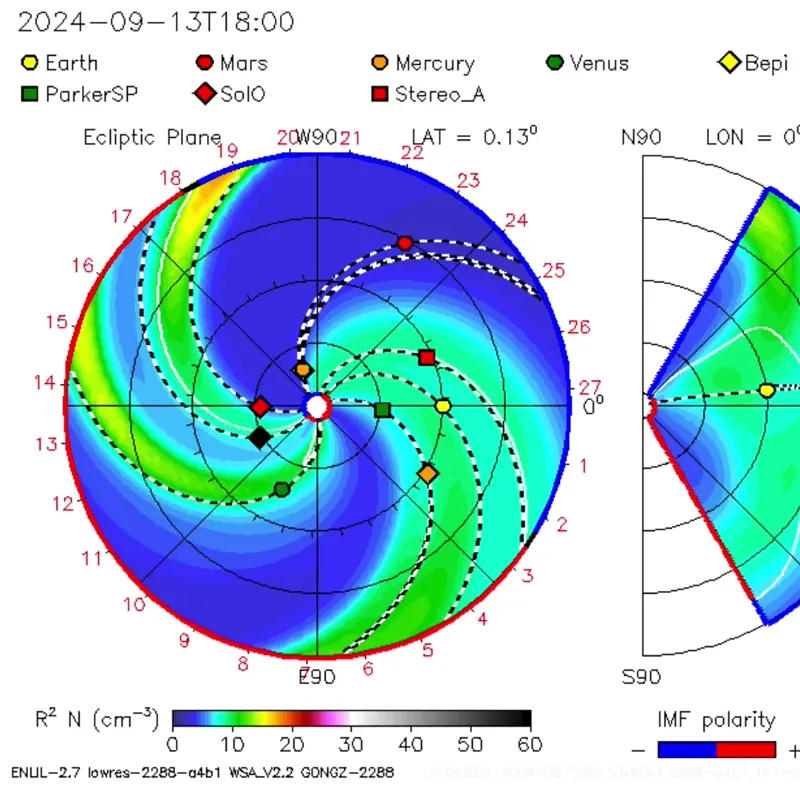
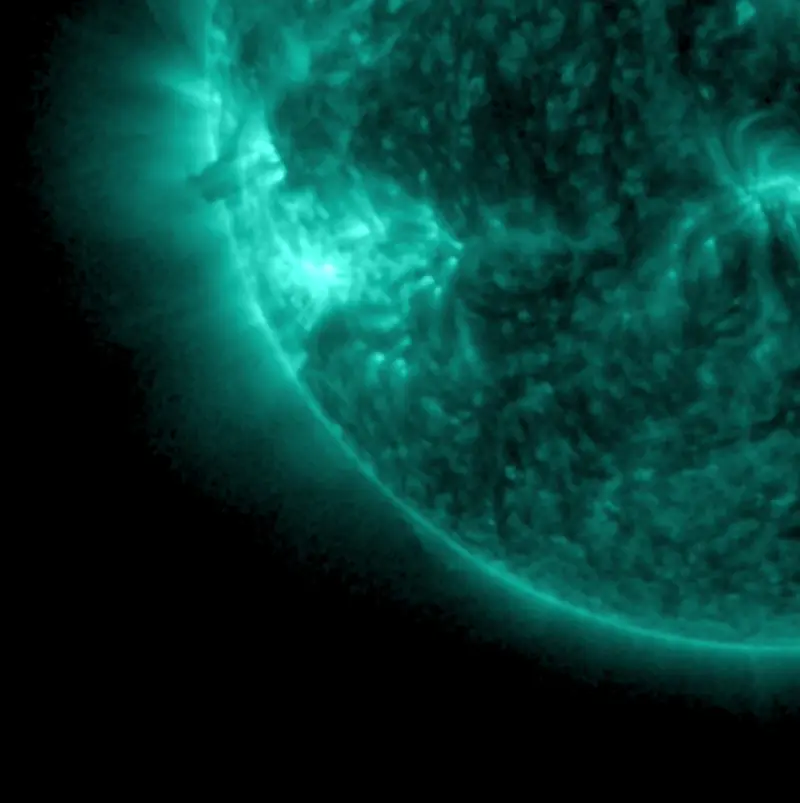
Northern Lights over the city of Östersund, #Sweden
Last night was just crazy good with some really colorful and strong Northern Lights.
Nikon Z9 with Nikon Z 14-24mm f/2,8 S@NikonEurope #NorthernLights #Aurora #Norrsken pic.twitter.com/qtEGInYZQs
— Göran Strand (@Astrofotografen) September 13, 2024
The aurora is going CRAZY in Kiruna, Sweden as CME effects continue! pic.twitter.com/w1VfJe1ub7
— Landon Moeller (@landon_wx) September 13, 2024
The Northern lights over Stonehenge this morning ??? Photo credit Nick Bull ?#aurora #auroraborealis #northernlights #beautiful #night #september #autumn #SolarMaximum pic.twitter.com/7D8NjJ3RQt
— Stonehenge U.K (@ST0NEHENGE) September 13, 2024
Early hours of 13/09/24 on banton Loch – superb to see & worth being like a burst cushion today after getting to bed sometime after 5am #Scotland #aurora #kilsyth @TamithaSkov @StormHour pic.twitter.com/RMhs7TcQf2
— Cat Perkinton (@catperkinton) September 13, 2024
Sun news September 13: Burst of auroras, more tonight?
Observers at high latitudes witnessed a powerful burst of geomagnetic storming over the past 24 hours. We saw G3 (strong) geomagnetic storm levels. The blast to our magnetic field came from chunks of sun-stuff – coronal mass ejections, aka CMEs – that left the sun on September 8 and 10. Conditions for G1 (minor) geomagnetic storming are expected for the rest of the day today through tomorrow, September 14. At the time of this writing, a Kp = 4 is ongoing. Bring those cameras out for those beautiful photos. Did you see the auroras last night? Please share your beautiful photos with us.
Last 24 hours: Solar activity was high over the past day, with eight M flares including three greater than M5. Between 11 UTC yesterday to 11 UTC today, our star produced 19 flares, eight M and 11 C flares. There were three M flares larger than M5; the largest was an M6.9 flare at 14:43 UTC on September 12 from AR3811. The lead flare producer of the period was active region AR3811, which produced 11 flares, five M and six C flares. The list of the M flares is:
• M1.2 at 13:21 UTC on September 12 from AR3811. R1 (minor) radio blackout over the Atlantic Ocean.
• M6.9 a 14:43 UTC on September 12 from AR3811. R2 (moderate) radio blackout over the Atlantic Ocean north of Brazil. The largest.
• M1.6 at 15:06 UTC on September 12 from AR3825. R1 (minor) radio blackout off the north coast of Brazil.
• M2.1 at 22:27 UTC on September 12 from AR3825. R1 (minor) radio blackout in the middle of the Pacific Ocean south of Hawaii.
• M1.7 at 1:37 UTC on September 13 from AR3811. R1 (minor) radio blackout in the middle of the Philippine Sea.
• M5.3 at 6:56 UTC on September 13 from AR3811. R2 (moderate) radio blackout over the Arabian Sea.
• M5.2 at 7:08 UTC on September 13 from AR3811. R2 (moderate) radio blackout over the Arabian Sea.
• M2.9 at 8:37 UTC on September 13 from AR3825. R1 (minor) radio blackout over the Arabian Sea off the east coast of Somalia.
A group of active regions is now departing in the solar southwest, soon to be carried out of view by the sun’s rotation. One of them AR3811, the lead flare producer of the past day, provided a show with flares, jets, and prominences. AR3814 is the largest active region on the sun’s Earth-facing disk now. It’s also the only active region with beta-gamma-delta magnetic complexity, indicating a potential for strong flaring. The sun has seven active regions on the Earth-facing disk. Note: AR3825 is not on our daily image below, as it was labeled after the image was produced. By the way, one of the two large coronal holes we’ve been observing will move into a geoeffective position beginning around September 15, meaning we’ll start receiving its fast solar wind at Earth, for more possible auroral displays.
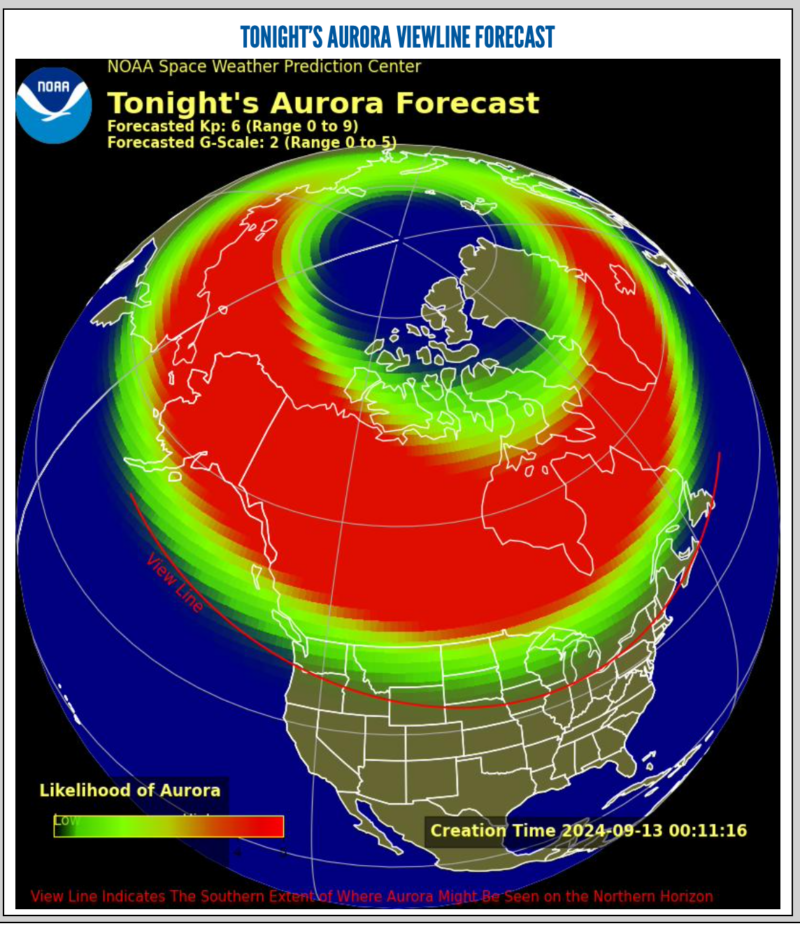
South Indian Lake, Manitoba, gave me an unforgettable aurora experience tonight 9/12/24
So glad I caught that intense red glow just in time! Didn’t let the rain forecast for tomorrow get me down! #AuroraBorealis #ManitobaMagic @theauroraguy #aurora #northernlights #solarstorm pic.twitter.com/mk2GDxOqsP
— Rj Roldan ™ ? (@rjayroldan) September 12, 2024
Early this morning I went aurora chasing for 3 hours along highway 4, looking for a gap in the fog & clouds. I found 15 minutes worth of this wild & crazy sky (condensed into this time lapse)! #vancouverisland pic.twitter.com/1PClsibfdv
— David McColm (@davidlmccolm) September 12, 2024
With just minutes to spare. I arrived at the only clear beach in my area, mukilteo. I got to focus stacking this drift wood log right before the arc erupted into some of the best naked eye reds I’ve seen yet! #solarstorm #aurora #pnw pic.twitter.com/hkQbtOwUMD
— mark stewart (@StewarrMark) September 13, 2024
The pinks were very vibrant last night in Fairbanks, Alaska. Here are just a couple shots. pic.twitter.com/O4UOFvfWr5
— Vincent Ledvina (@Vincent_Ledvina) September 12, 2024
Sun news September 12: X flare earlier today
After a relatively slow week … X flare this morning! It was an X1.3 at 8:43 UTC on September 12 from the southeast limb (edge). This flare produced an R3 (strong) radio blackout affecting an area over Eastern Africa, Uganda.
Last 24 hours: Overall, the sun produced the X flare – and more M flares than C flares in the past day (11 UTC yesterday to 11 UTC today) – bringing solar activity to high. The sun produced 19 flares, an X, 10 Ms and eight C flares. The lead flare producer of the period was active region AR3811, which produced seven flares, five M, and two C flares. The list of the X and M flares is:
M1.8 at 12:36 UTC on September 11 from AR3814. R1 (minor) radio blackout over Liberia.
M1.4 at 15:18 UTC on September 11 from AR3811. R1 (minor) radio blackout over the Atlantic Ocean off northeast coast of Suriname.
M1.9 at 15:30 UTC on September 11 from an unnumbered region in the southeast. R1 (minor) radio blackout over Suriname.
M1.6 at 17:26 UTC on September 11 from AR3811. R1 (minor) radio blackout over the Pacific Ocean off the west coast of Colombia.
M2.0 at 17:52 UTC on September 11 from AR3814. R1 (minor) radio blackout over Pacific Ocean north of Puerto Ayora.
M5.0 at 0:12 UTC on September 12 from AR43811. R1 (minor) radio blackout over the Pacific Ocean.
M1.0 at 4:04 UTC on September 12 from AR3811. R1 (minor) radio blackout over South China Sea.
M1.2 at 4.32 UTC on September 12 from AR3815. R1 (minor) radio blackout over Malaysia.
M2.7 at 6:18 UTC on September 12 from AR3811. R1 (minor) radio blackout over the Indian Ocean southeast of Sri Lanka.
X1.3 at 9:43 UTC on September 12 from unnumbered active region on the southeast. R3 (strong) radio blackout over Uganda.
Active region AR3814 is the largest in extent on the sun’s Earth-facing disk. It’s the only one with beta-gamma-delta magnetic complexity, indicating a potential for strong flaring. The sun has eight active regions on the Earth-facing disk. We continue to observe two large coronal holes on the solar disk. Soon, they will move into a geoeffective position, meaning they’ll be capable of sending their fast solar wind to Earth, perhaps enhancing auroral displays.
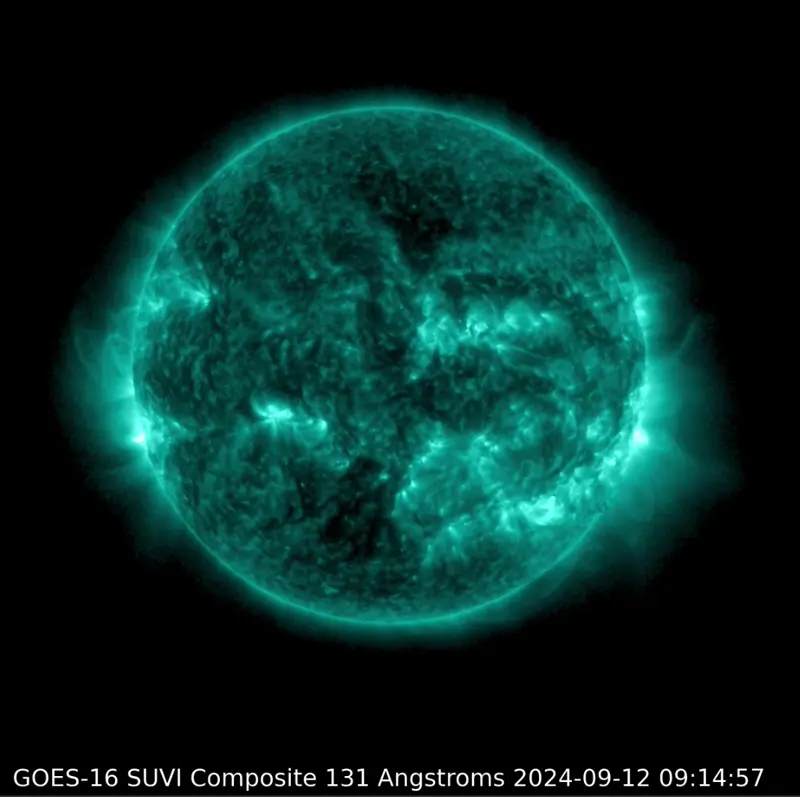
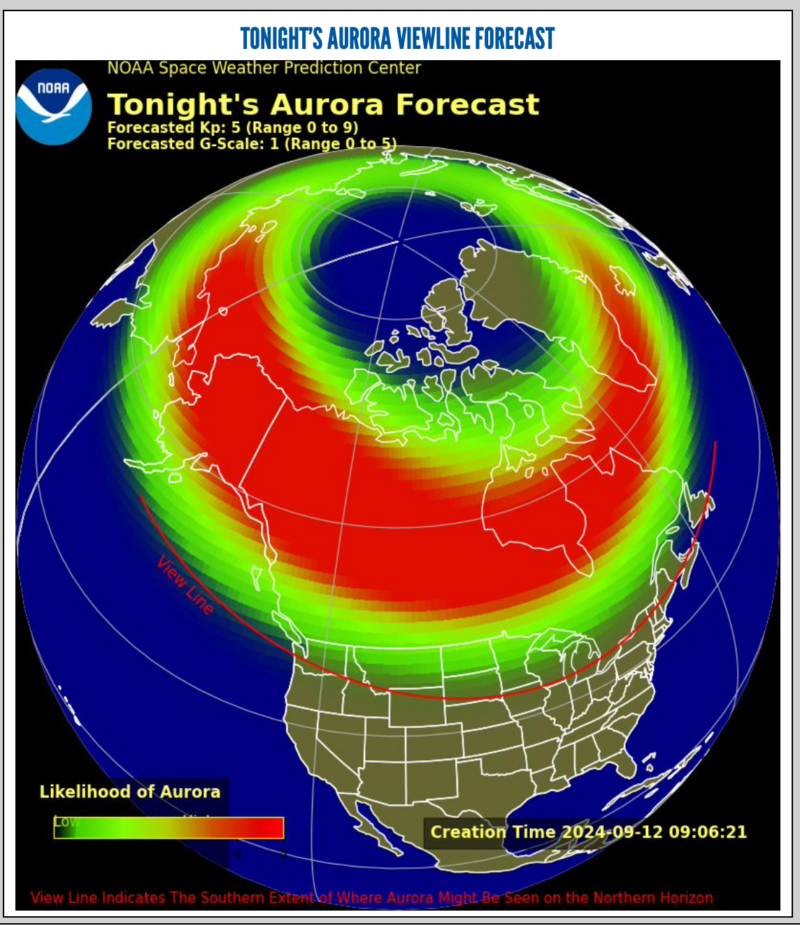
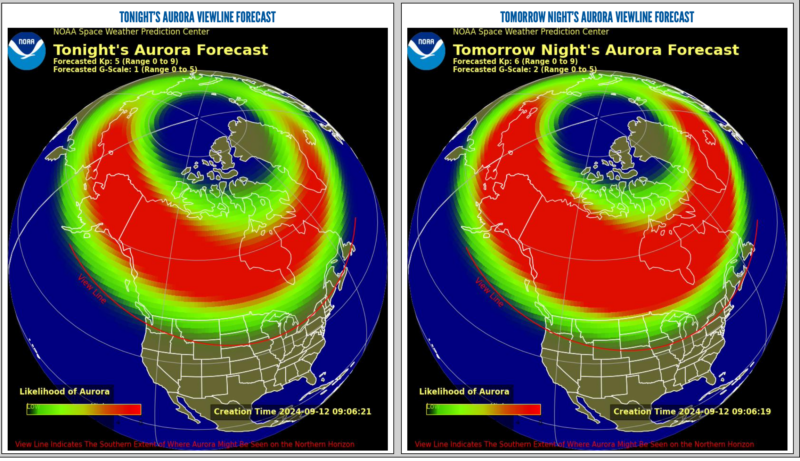
Sun news September 11: Sun-stuff headed our way
A blob of solar material and magnetic fields is coming our way. Yesterday’s M1.2 flare from AR3814 produced a full halo event – an event which suggests sun-stuff might be headed toward Earth – and indeed a component of the coronal mass ejection (CME) is now confirmed via computer models (like the ENLIL model shown on this page) to be heading to Earth. Arrival is expected by late September 12 bringing conditions for a G1 to G2 (mild to moderate) geomagnetic storm. The effects could be extended up to September 13. NOAA issued an alert for possible auroral displays to be seen in high north latitudes as far south as the states of New York and Wisconsin in the U.S. Stay tuned!
Last 24 hours: Low flaring production characterized the past day (11 UTC yesterday to 11 UTC today), but two faint M flares kept solar activity at moderate levels. Over the past day, during our observation period between 11 UTC yesterday to 11 UTC today, the sun produced 11 flares, two M and nine C flares. The largest was an M1.6 flare produced at 15:47 UTC on September 10. It came from active region AR3806. An R1 (minor) radio blackout affected an area over the Atlantic Ocean. The second M flare of the period was an M1.0 at 23:50 UTC on September 10 from AR3814. It produced an R1 (minor) radio blackout over the Pacific Ocean southwest of Hawaii. The lead flare producer of the period was sunspot region AR3820 with four C flares. Active region AR3814 is the largest in extent and the only one with beta-gamma-delta magnetic complexity. The remaining labeled active regions show simpler alpha and mostly beta configurations. The sun has eight sunspot regions on its Earth-facing side. We continue to observe the two large coronal holes on the solar disk. Soon, they will move into a geoeffective position, meaning they’ll be capable of sending their fast solar wind to Earth, perhaps enhancing auroral displays.

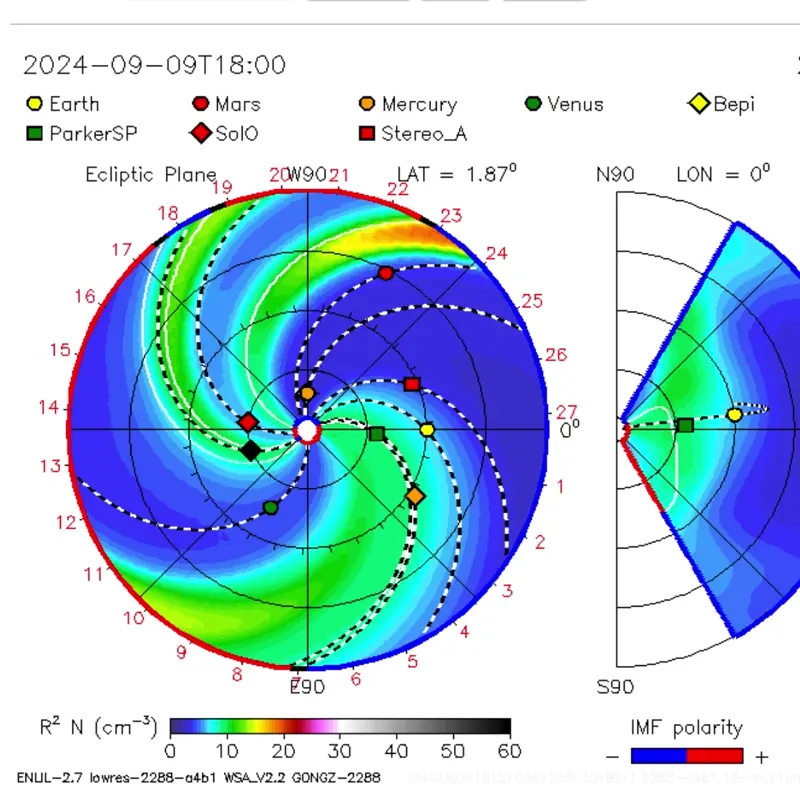
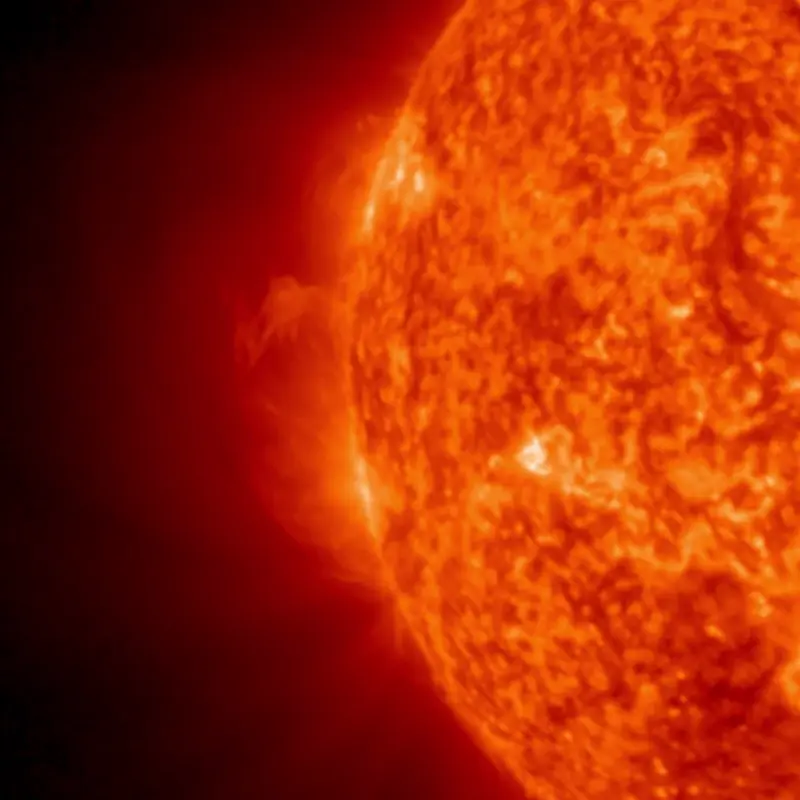
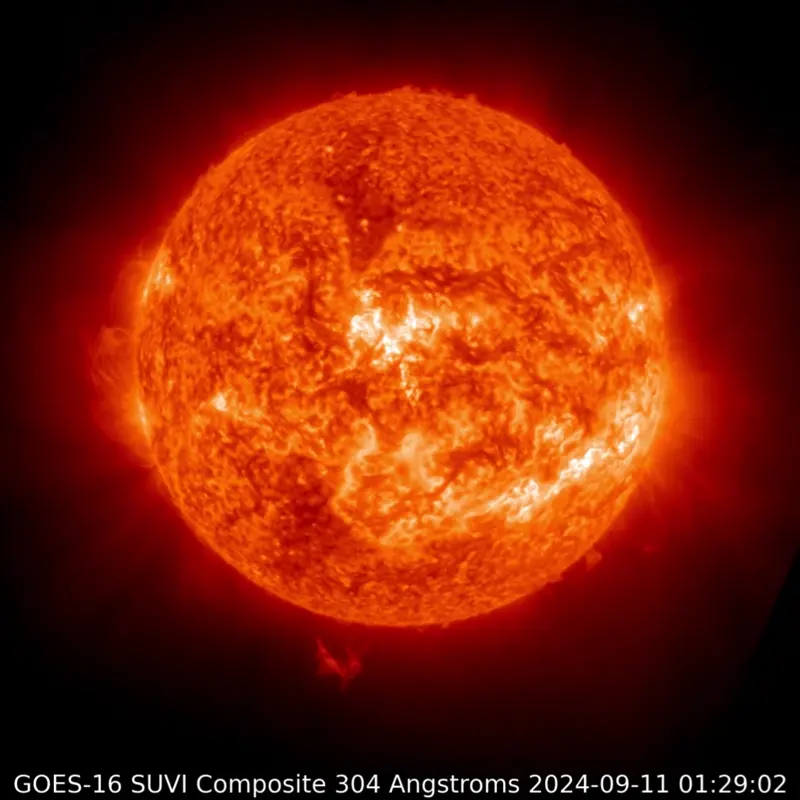
Sun news September 10: Storms and filaments
Sun activity has been moderate in the past day (11 UTC yesterday to 11 UTC today), with three M flares. And we’re having fun watching filaments on the sun’s disk – glowing ropes of solar material and magnetic fields, arcing up from the sun’s visible surface – as we wait today for possible geomagnetic storms at Earth. The sun’s disk is covered with filaments now, which could bring some eruptions. We also see prominences – the same thing as filaments, but seen on the sun’s limb (edge) – extending into space from the sun’s north and south poles. Meanwhile, a coronal mass ejection (CME) that left the sun on September 8 is expected at Earth today. This anticipated arrival should bring geomagnetic storms at the level of G1 to G2 (mild to moderate). Depending on when the CME arrives – and which part of Earth is experiencing darkness at that time – you might get auroras. Get your aurora watching gear ready, and stay tuned.
Last 24 hours: Solar activity is moderate. In the last 24 hours the sun produced nine flares, three M and six C flares. The largest was an M3.4 at 17:08 UTC on September 9 from active region AR3814. The blast caused an R1 (minor) radio blackout affecting an area over the Caribbean Sea off the north coast of Colombia.
The list of M flares is:
• M1.0 at 12:17 UTC on September 9 from AR3811. R1 (minor) radio blackout over Ghana.
• M3.4 at 17:08 UTC on September 9 from AR3814. R1 (minor) radio blackout over the Caribbean Sea off the north coast of Colombia.
• M1.2 at 0:16 UTC on September 10 from AR3814. R1 (minor) radio blackout over the Pacific Ocean.
Only sunspot region AR3814 kept its beta-gamma magnetic complexity. The remaining labeled active regions show simpler alpha and mostly beta configurations. The sun has nine sunspot regions on its Earth-facing side. We welcomed a newcomer, AR3822. It emerged in the northeast quadrant east of AR3814. Two large coronal holes also emerged on the Earth-facing side of our star, one in the northeast quadrant and the second in the southeast.
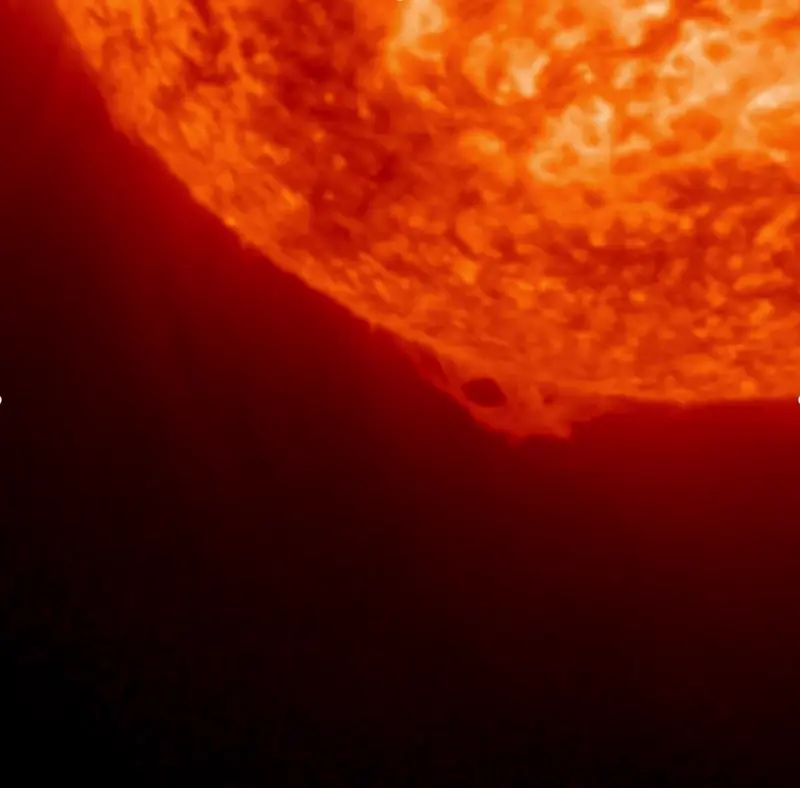


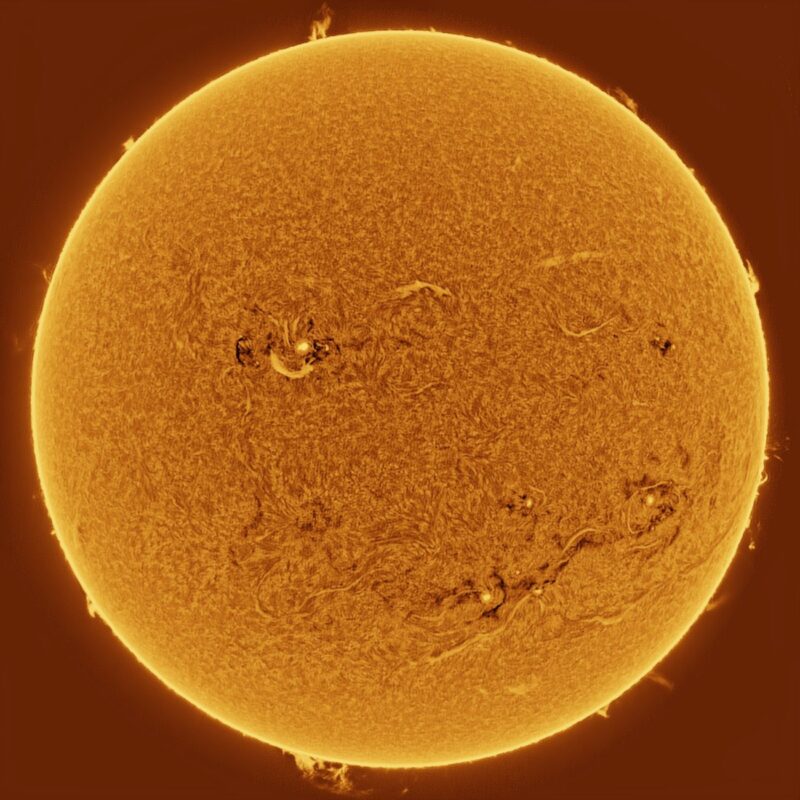
Sun news September 9: Activity picking up?
After a quiet weekend, things may be picking up. Over the past 24 hours (11 UTC yesterday to 11 UTC today), we’ve had four M flares (moderately strong flares), along with nine C-class (lesser) events. Also, one of the flares just over the sun’s western limb (edge) – either AR3806 or AR3807 – caused a solar particle event, also known as a radiation storm. This is an event in which solar particles, mostly protons, become accelerated in the sun’s atmosphere. The M1.1 flare causing the event happened around 3:30 UTC on September 9. High energy protons reached S1 (minor) radiation storm levels. At the time of this writing (11 UTC on September 9), the solar particles are causing additional radio communications disruptions near the North and South Poles on Earth. The flare and particle event had an associated eruption, producing a coronal mass ejection (CME) toward the west. The CME does not appear to have an Earth-directed component, but we await additional coronagraph imagery. Another eruption occurred off the sun’s northeast limb (edge), just behind the limb. This event, also, doesn’t to have an Earth-directed component, but we will need to wait for more data. Stay tuned.
Last 24 hours: Activity has picked up in the last 24 hours, reaching moderate levels, with four small M flares. It is difficult to determine exactly which active region is the source for the flares on the sun’s limb, because two regions are just over the southwest limb (edge): AR3806, AR3807, and AR3808. These regions produced three of the four flares including the one with the associated solar particle event and radiation storm. The sun produced 13 flares, four M and nine C flares.
The list of M flares is:
• M1.6 at 15:30 UTC on September 8 from AR3811. R1 (minor) radio blackout over the northeastern tip of South America.
• M1.0 at 03:31 UTC on September 9 from AR3806/07/08. R1 (minor) radio blackout over Indonesia.
• M1.9 at 05:45 UTC on September 9 from AR3806/07/08. R1 (minor) radio blackout over Southeast Asia.
• M1.5 at 08:50 UTC on September 9 from AR3806/07/08. R1 (minor) radio blackout over East Africa.
• M1.5 at 08:50 UTC on September 9 from AR3806/07/08. R1 (minor) radio blackout over East Africa.
Only AR3811 and AR3814 have beta-gamma magnetic complexity. The sun has nine regions on the disk.
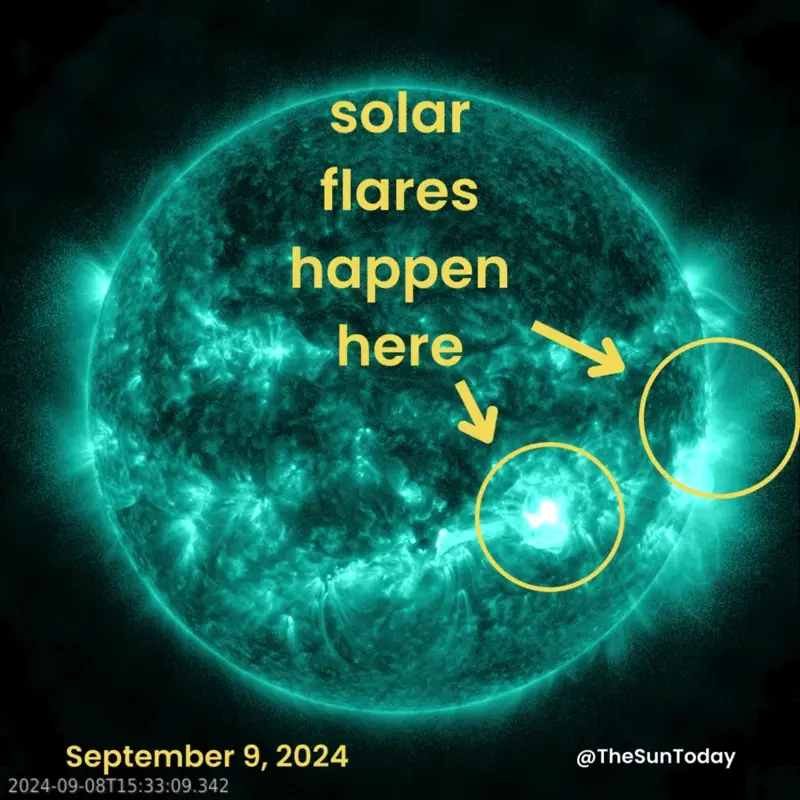
Sun news September 8: A dark filament eruption
Happy Sun Day! For many, today is a day for relaxing and stepping into some downtime. The sun is taking this seriously. The flaring size and rate is low. We also have no new Earth-directed coronal mass ejections (CMEs). But the filament eruption yesterday – associated with an M flare and region AR3813/15 – might give Earth a glancing blow on September 11. NASA models say yes on this possibility, but NOAA models say no (see below). We will have to wait and see. The most exciting action today is from a nice, dark filament eruption. The eruption comes from just northwest of disk center. We can see a bright ribbon on the sun after the filament launches. As the filament flys away from the sun it looks like a shadow moving away. It is dark because the material is cooler than the sun behind it. We on’t yet know if any of the sun stuff will head our way. Stay tuned!
Last 24 hours: It is a day of low activity, with only C flares. During our observation period (11 UTC yesterday to 11 UTC today), our star produced nine C flares. This is a reduction in flaring rate in contrast with the last several days. There’s no longer any region on the Earth-facing sun now with a delta magnetic complexity, indicative of strong flare potential. Regions AR3806, AR3811, AR3813, and AR3815 have beta-gamma magnetic complexity. All these regions have an increased potential for producing M or X flares, but not as much so as a beta-gamma-delta region. The sun now has eight sunspot regions on its Earth-facing disk, including two newcomers, AR3818 and AR3819.

Sun news September 7: Prominence and filament fun
Solar excitement over the past 24 hours focused on filament and prominence activity captured in the 304 angstroms wavelength. The solar limb (edge) was covered with solar prominences, most of which were stable and dancing around. A filament in the southeast erupted in a southward direction around 17:05 UTC. Around 7:30 UTC, we observed loops expanding out from behind the southern solar limb (edge). The very last available SOHO LASCO C2 image shows the beginnings of a coronal mass ejection headed southward. We await more data to learn the details of the event. The flaring activity remains moderate, but just barely, with an isolated small M flare from AR3813. We are very curious about this region or regions on the solar backside. One or more interesting regions could soon rotate into view. Stay tuned!
Last 24 hours: Once again, an isolated M flare during our observation period (11 UTC yesterday to 11 UTC today) kept solar activity at moderate levels. Flaring production reduced from 22 flares to 16 flares, with one M and 15 C flares. The largest flare, an M1.7, blasted out at 7:46 UTC on September 7 from active region AR3813. The flare caused an R1 (minor) radio blackout affecting an area over the Indian Ocean off the west of the Maldives. The lead flare producer of the period was active region AR3806 in the southwest, which produced seven C flares. One of the most active regions during the week, sunspot region AR3807 is now completely out of view in the southwest. Of the seven numbered active regions on the solar disk, there are three sunspot regions with a beta-gamma magnetic configuration: AR3806, AR3811 and AR3813. Active region AR3813 split into two. The western portion kept the number AR3813 while the eastern region is now AR3815. There is a newcomer on the southeast quadrant, AR3816.
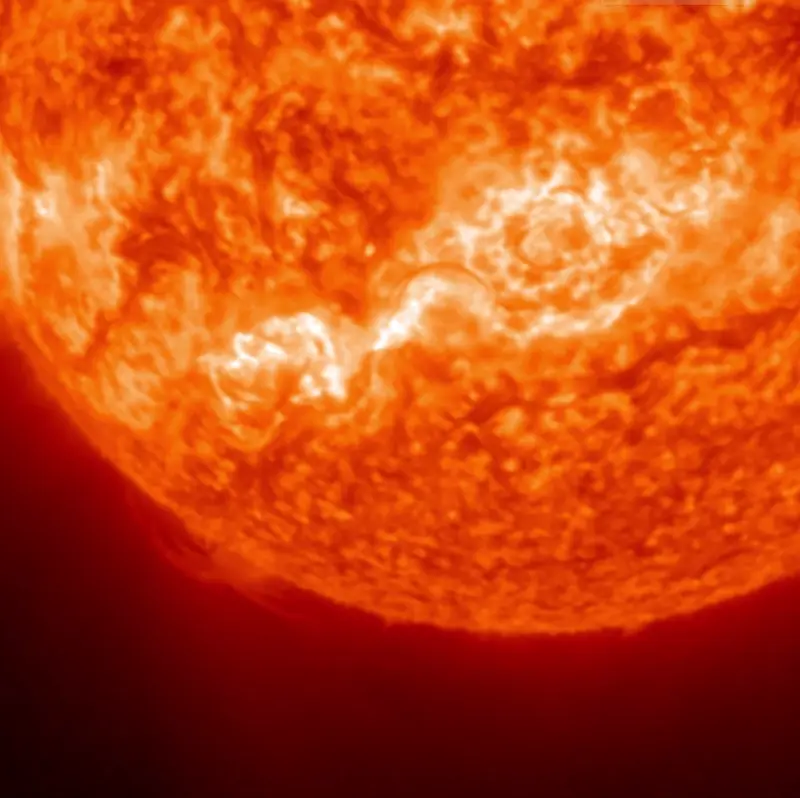
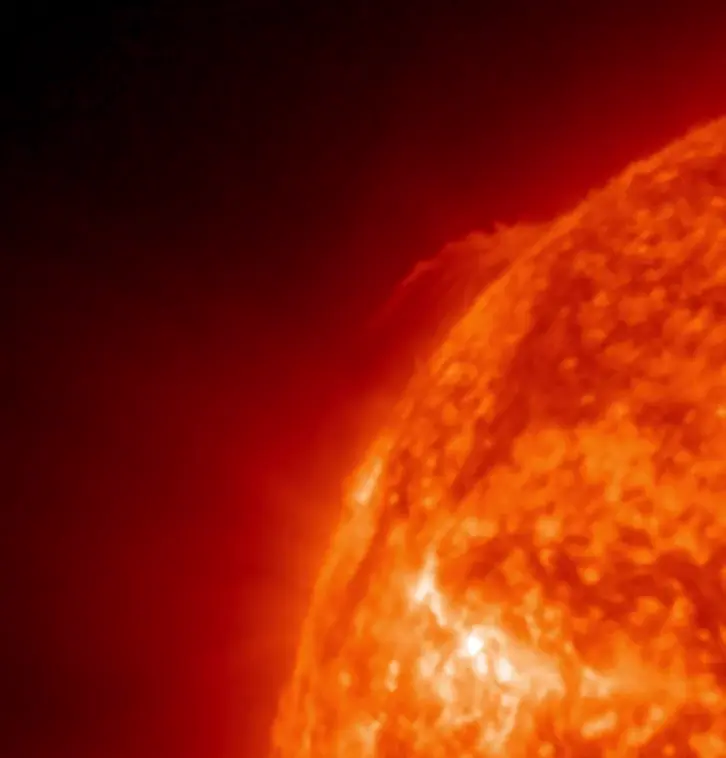
EarthSky’s editor-in-chief Deborah Byrd spoke LIVE with heliophysicist C. Alex Young of Goddard Space Flight Center at 12:15 pm CDT/1:15 pm EDT (17:15 UTC) on Friday, September 6, 2024. Alex is also a co-author of our daily sun update. He told us about this week’s most important sun news: the biggest sunspot number of Solar Cycle 25 so far. Watch the replay.
Sun news September 6: X flare on the sun’s far side
The latest solar excitement has come not from the solar disk facing us, but from the sun’s far side. The SOHO spacecraft’s LASCO C2 and C3 coronagraphs observed a full halo coronal mass ejection (CME), which sometimes means that sunstuff has been blasted straight at Earth … but no eruption was observed on the solar disk. This indicated that the blast actually came from the sun’s rear. And sure enough, the NASA Enlil computer model shows a CME hurled from the far side of the sun. The model estimates that the CME will miss Mercury and will not impact any planet or spacecraft. The STIX instrument onboard Solar Orbiter observed the event, and estimated it to have been caused by a huge X2 flare. So it would have been a big impact if it was heading toward Earth, rather than the opposite direction!
Last 24 hours: Sun activity remains moderate after an isolated M flare. During our observation period (11 UTC yesterday to 11 UTC today), we saw an increase in flare production to the single M flare and 21 C flares. The largest flare was an M1.3 flare produced at 13:25 UTC on September 5 by AR3807. The blast caused an R1 (minor) radio blackout affecting an area over the Atlantic Ocean off the west coast of Africa. The lead flare producer was again AR3807, which blasted 15 flares: the M1.3 and 14 C flares. This departing region also hurled plasma jets into space. There are two active regions on the Earth-facing side of our sun with high-potential beta-gamma-delta magnetic configurations: AR3806 and AR3811. AR3807 and AR3813 have beta-gamma complexities, although it should be noted that AR3807 is too far around the limb (edge) to obtain a reliable magnetic configuration measurement. There are currently six numbered active regions on the solar disk.
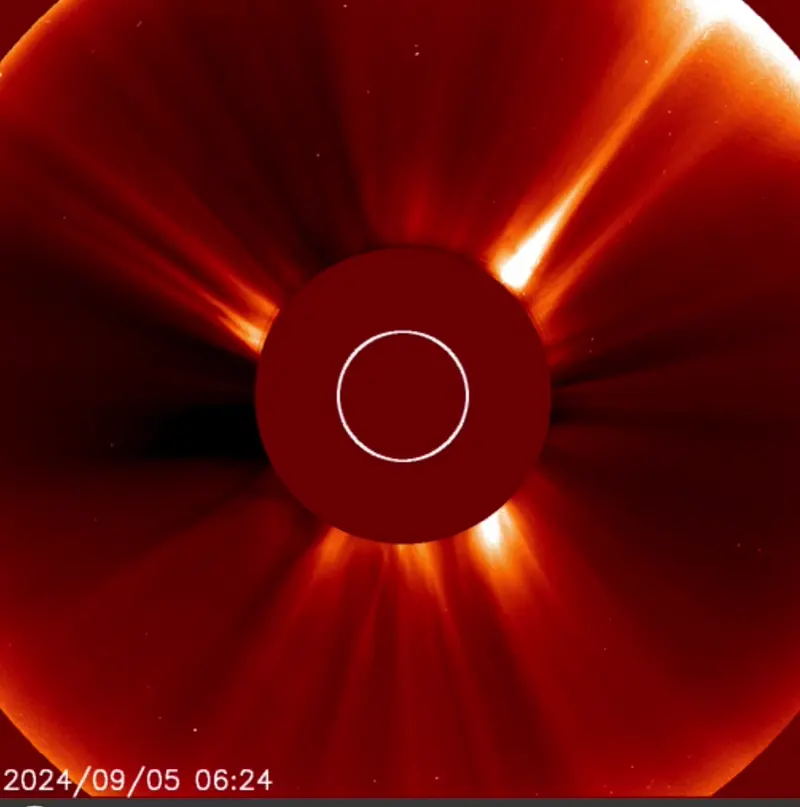
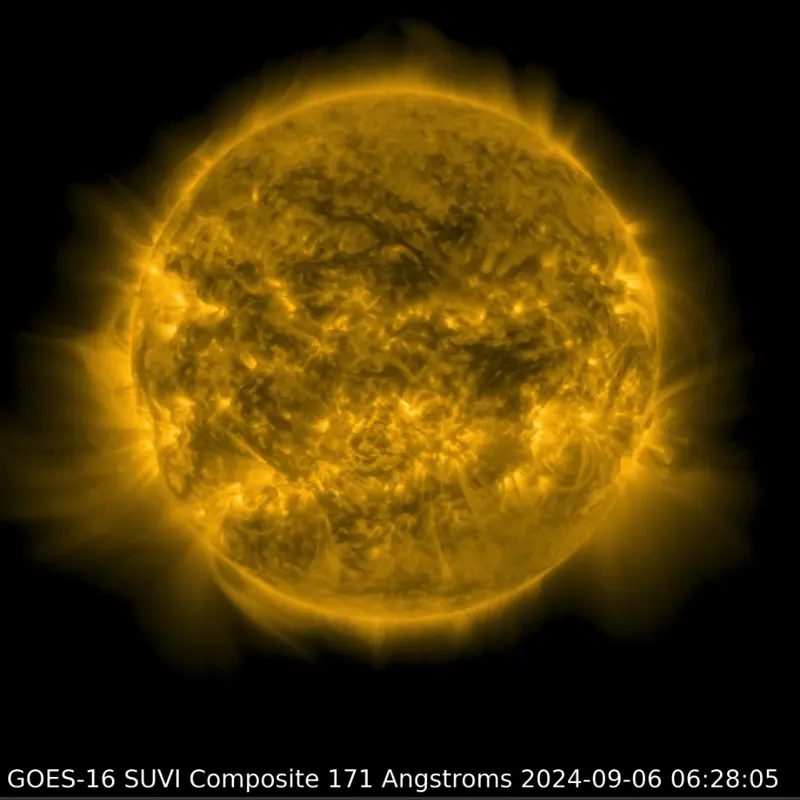
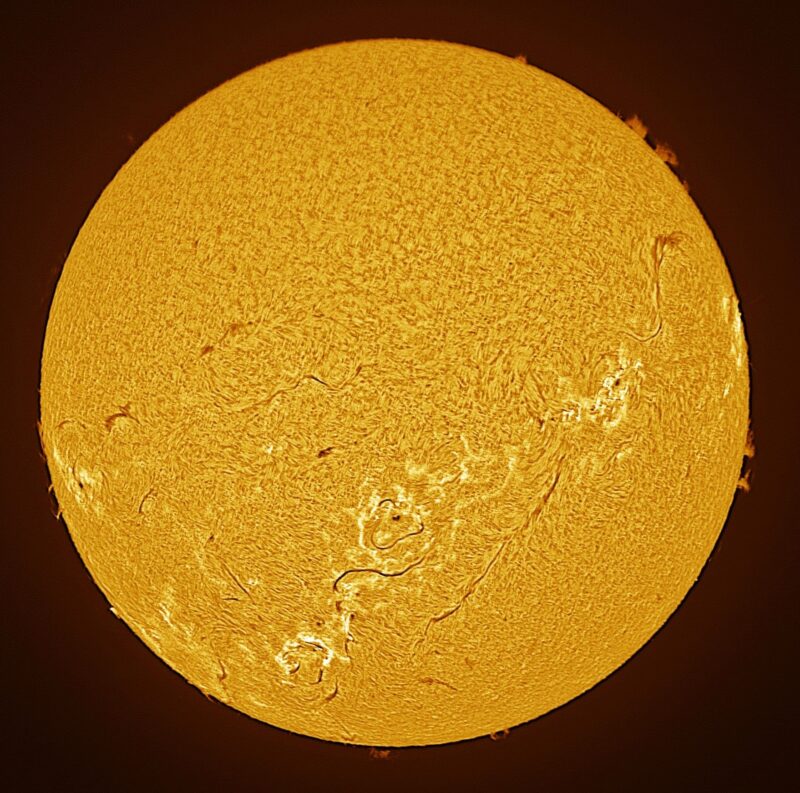
Sun news September 5: Active region goes out with a bang
One of the week’s most active regions has begun to depart over the sun’s southwest limb (edge). It isn’t leaving quietly, though, producing an M2.8 flare on its way out. The largest of 7 M flares produced over the past 24 hours, this blast caused an R1 (minor) radio blackout affecting an area over Somalia. The other blast of excitement came from a filament spewing beautiful jets near AR3811. See the imagery below, along with the cool sight of Earth’s shadow eclipsing the sun from the view of the GOES-R satellite.
Last 24 hours: Seven small M flares have kept solar activity at moderate levels over the past day (11 UTC yesterday to 11 UTC today). The sun produced a total of 20 flares, with 13 C flares adding to the Ms. The largest was an M2.8 at 8:56 UTC on September 5 from AR3807. The event caused an R1 (minor) radio blackout affecting an area over Somalia. The lead flare producer of the period was active region AR3807, which blasted nine flares: three Ms and six Cs. It was closely followed by AR3811, which produced six flares: 2 M and four Cs. The list of M flares is:
• M1.0 at 13:21 UTC on September 4 from AR3813. R1 (minor) radio blackout out over West Africa.
• M1.2 at 20:00 UTC on September 4 from AR3811. R1 (minor) radio blackout out in the middle of the Pacific Ocean southeast of Hawaii.
• M1.0 at 0:20 UTC on September 5 from AR3807. R1 (minor) radio blackout over the Pacific Ocean southwest of Hawaii.
• M1.2 at 3:25 UTC on September 5 from AR3806. R1 (minor) radio blackout over the Philippine Sea off the east coast of the Philippines.
• M1.0 at 3:44 UTC on September 5 from AR3813. R1 (minor) radio blackout over the Philippines.
• M2.8 at 8:56 UTC on September 5 from AR3807. R1 (minor) radio blackout over Somalia. The largest.
• M1.6 at 9:42 UTC on September 5 from AR3807. R1 (minor) radio blackout over Ethiopia.
Sunspot region AR3806 kept its potent beta-gamma-delta magnetic configuration, while AR3807 and AR3813 are showing a beta-gamma complexity. The sun has six numbered active regions on its Earth-facing side. There is a newcomer on the northeast limb (edge), now numbered AR3814. Will this new region match the potential of AR3806 and AR3813 and kick up activity?

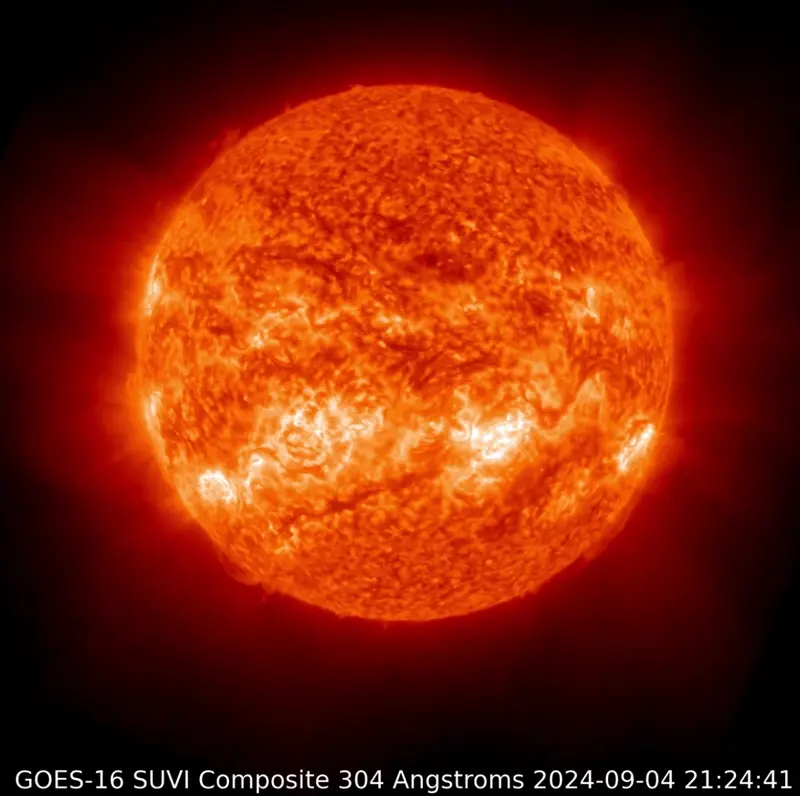

Image via NOAA.
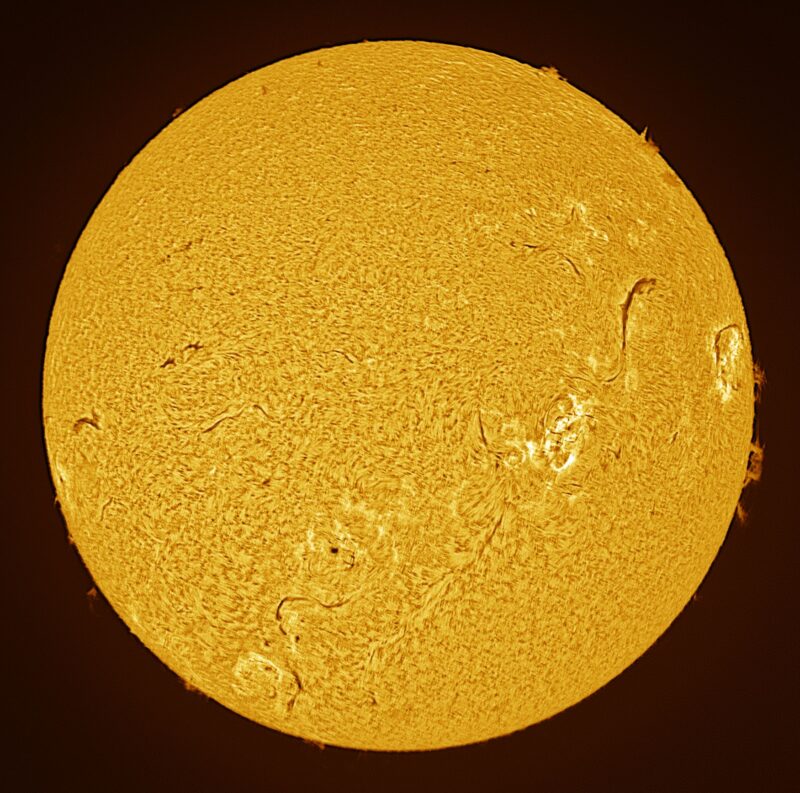
Sun news September 4: Exciting sunspot regions!
Sun activity has been moderate, and was still moderate over the past day. But is higher activity on the horizon? Maybe! Three sunspot regions, AR3806, AR3807, and AR3813, collectively show some exciting potential. These regions – plus a new region on the sun’s northeast limb (edge) – are pushing toward high levels. Over the past day, the three numbered regions produced 20 flares, six M-class, and two approaching M5 (threshold for high activity). The fourth region shows off the sun’s northeastern limb (edge), indicating potential action for that sunspot region once it rotates into view. These regions are magnetically complex, with AR3806 and AR3807 containing delta regions (a sign of the potential for strong M or even X flares). AR3807 is now approaching the sun’s western limb (edge). Soon, the sun’s rotation will carry it out of view. Still, its location on the Earth-facing disk means that – if it produces any solar energetic particles – the chance for them to reach Earth is high, given the location of the sun’s spirally magnetic field with respect to Earth. On the other hand … the sun could surprise us and suddenly quiet down. What will happen? Stay tuned!
Last 24 hours: Sun activity was moderate over the past day (11 UTC yesterday to 11 UTC today), with only M and C flares. During this period, the sun produced six M and 14 C flares. The main flare producer of the past day was AR3806, with 2 M and 6 C flares. AR3813 is in a close second with 4 M and one C flare. AR3807 produced four C flares. AR3806 and AR3807 have beta-gamma-delta magnetic complexity. AR3813 has beta-gamma complexity. All three regions produced flares in the last 24 hours and are worth watching. Yesterday’s far-side eruption produced an increase in solar energetic particles that were measured at Earth, and its effects can be seen as minor snow in SOHO LASCO coronagraph images. The largest flare of the day was an M3.3 at 16:02 UTC on September 3 from AR3813. An R1 (minor) radio blackout affected an area over the Americas.
The list of M flares is:
* M3.3 at 16:02 UTC on September 3 from AR3813. R1 (minor) radio blackout over the Americas. The largest.
* M2.9 at 16:13 UTC on September 3 from AR3813. R1 (minor) radio blackout over the Americas.
* M1.5 at 02:44 UTC on September 4 from AR3813. R1 (minor) radio blackout over Asia.
* M1.3 at 04:56 UTC on September 4 from AR3813. R1 (minor) radio blackout over Asia.
* M1.0 at 06:01 UTC on September 4 from AR3806. R1 (minor) radio blackout over Asia.
* M1.0 at 06:11 UTC on September 4 from AR3806. R1 (minor) radio blackout over Asia.
The sun now has seven numbered active regions on its Earth-facing side.

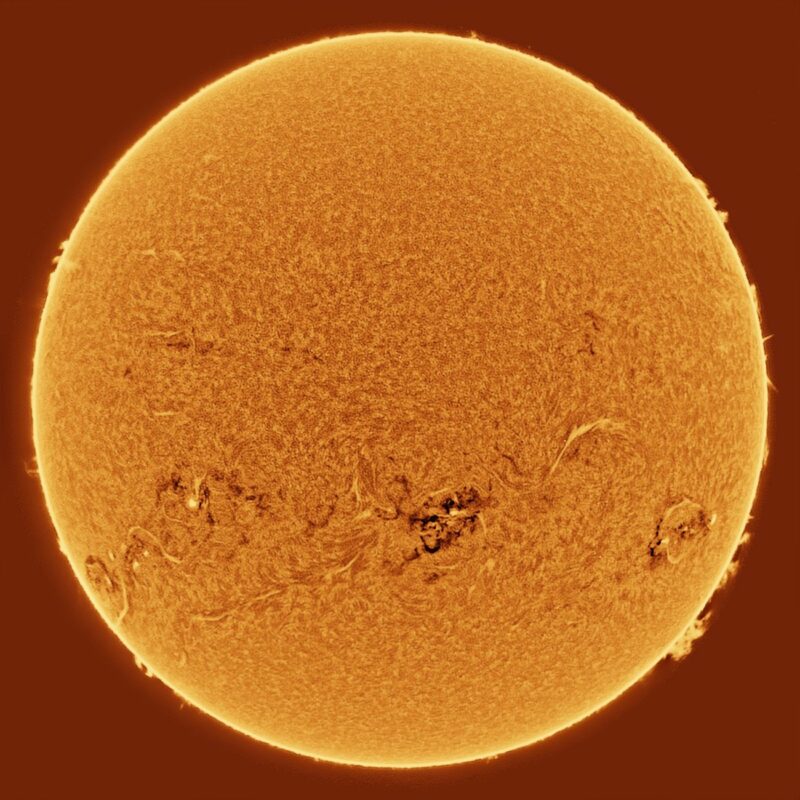
Sun news September 3: August was the peak of Solar Cycle 25, so far
It’s official: the monthly sunspot number for August 2024 is the highest for Solar Cycle 25 so far. The sunspot number for August 2024 reached a 215.5 value. It surpassed the previous peak for this solar cycle, which happened in July 2024, with a value of 196.5. The last time the monthly average was larger than 215.5 was 23 years ago, in September 2001 during Solar Cycle 23 (a value of 238.2). Will Solar Cycle 25 continue this trend? Will September have an even larger monthly sunspot number? Or have we reached Solar Maximum? Time will tell. We’ll be talking more about this on Friday during our all-new and all-cool Sun News of the Week livestream (scheduled for 12:15 p.m. CDT, or 17:15 UTC every Friday).
Last 24 hours: We just passed a period of peak sunspots! But the past week was relatively quiet, and activity has been moderate, with only M and C flares over the past day. The main flare producer of the past day was AR3807. It’s still showing promising potential for even more activity. Another region of interest is AR3813, which produced yesterday’s double M5+ flares with a fast coronal mass ejection (CME) that’s now heading to Venus (see yesterday’s entry). We also saw a large halo CME eruption from the sun’s far side, visible in the SOHO LASCO C2 coronagraph near the end of today’s observation period. From 11 UTC yesterday to 11 UTC today, the sun produced six M and 13 C flares. AR3807 had 13 flares, three Ms, and 10 Cs. The largest flare of the day was an M2.9 at 14:42 UTC on September 2 from AR3807. An R1 (minor) radio blackout affected an area over the Atlantic Ocean. The list of M flares is:
* M1.8 at 13:27 UTC on September 2 from southeast. R1 (minor) radio blackout over the Atlantic Ocean off the west coast of Africa.
* M2.9 at 14:42 UTC on September 2 from AR3807. R1 (minor) radio blackout over the Atlantic Ocean. The largest.
* M1.4 at 20:11 UTC on September 2 from AR3807. R1 (minor) radio blackout over the Pacific Ocean.
* M1.8 at 21:02 UTC on September 2 from southeast. R1 (minor) radio blackout over the Pacific Ocean.
* M1.6 at 23:01 UTC on September 2 from AR3807. R1 (minor) radio blackout over the Pacific Ocean in the middle of nowhere south of Hawaii.
* M1.5 at 7:22 UTC on September 3 from AR3813. R1 (minor) radio blackout over the Indian Ocean off southeast India.
The sun now has nine numbered active regions.

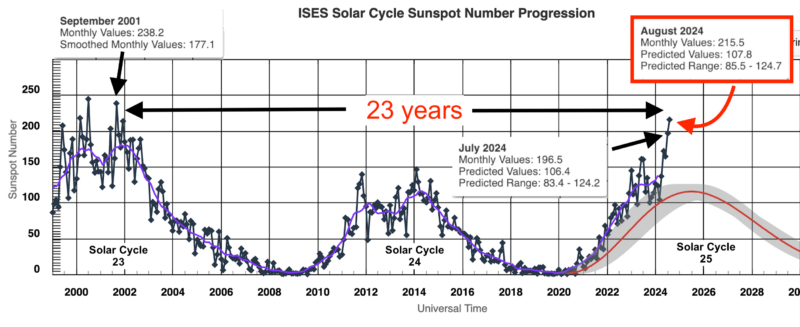
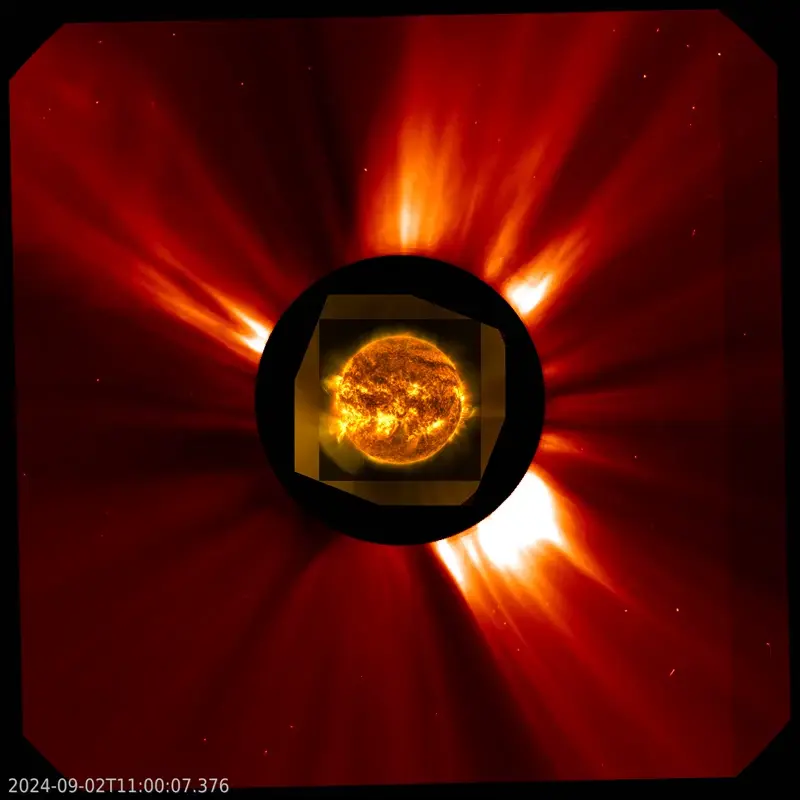
Sun news September 2: Large eruption headed to Venus
Shortly after yesterday’s sun news report, an at-the-time unnumbered region just over the sun’s southeast limb (edge) went BOOM! An eruption released a large flare made of two M5+ flares, along with a massive blob of sun stuff. Initial computer models from NOAA and NASA indicate that this eruption – called a coronal mass ejection (CME) – will not strike Earth. But look out, Venus, because it’s coming your way! Unlike our planet, Venus doesn’t have a magnetic field, the invisible force field that helps to protect our atmosphere from the ravages of the sun. We may never know for certain what impact this CME will have on the atmosphere of Venus, since there’s no orbiting spacecraft at Venus now. But this CME impact could strip some of the atmosphere away from Venus. By the way, this September 1-2 flare event might have been larger than could be measured from Earth. The flares took place just out of our view, and the sun blocked or occulted part of them. Now we wait to see if this new region will bring more action on the Earth-facing side of our star, as it rotates more fully into view. Stay tuned.
Last 24 hours: Sun activity is high, thanks to two M5+ flares. During our observation period (11 UTC yesterday to 11 UTC today), the sun produced five M and four C flares. This M activity came from a new region on or behind the southeast limb (edge) that we believe is the now-numbered region, AR3813. Active region AR3813 released the largest flare of the day, an M5.6, at 13:31 UTC on September 1. It caused an R2 (moderate) radio blackout over the Atlantic west of Africa. The lead flare producer of the period was active region AR3813, which produced five M flares. The list of M flares during the period:
• M5.5 at 13:22 UTC on September 1 from AR3813. R2 (moderate) radio blackout over the Atlantic Ocean west of Africa.
• M5.6 at 13:31 UTC on September 1 from AR3813. R2 (moderate) radio blackout over the Atlantic Ocean west of Africa.
• M1.1 at 20:00 UTC on September 1 from AR3813. R1 (minor) radio blackout over the Pacific Ocean west of the Americas.
• M1.5 at 22:48 UTC on September 1 from AR3813. R1 (minor) radio blackout over the Pacific Ocean west of the Americas.
• M2.0 at 05:29 UTC on September 2 from AR3813. R1 (minor) radio blackout over Asia.
Today, the sun has 11 numbered active regions, including two new numbered active regions, AR3812 and AR3813. AR3807 continued its growth while the remaining regions were stable or in decay.

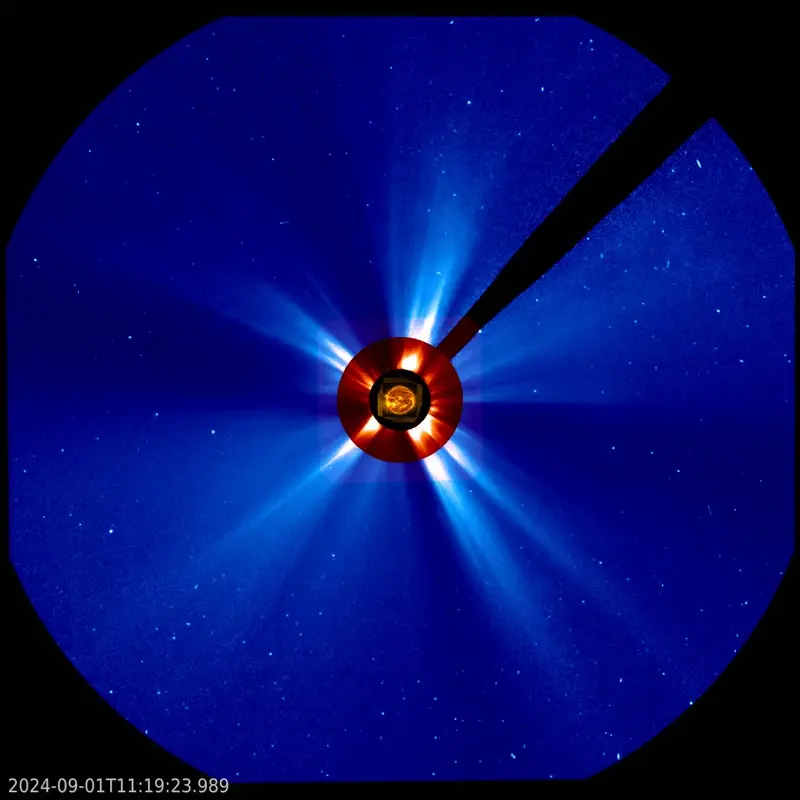
Sun news September 1: Activity coming over east limb
Activity has calmed slightly, but remained at moderate levels over the past day. Most of the approaching activity is rotating into view over the sun’s eastern limb. Region AR3806 looked promising, but has lost some of its flare-producing potential. During the last 24 hours, Earth’s magnetic field experienced a brief period of a G1 (minor) geomagnetic storming, thanks to high-speed solar wind from a coronal hole. After the geomagnetic storm, the geomagnetic field cooled to active, then quiet levels, and remains there at the time of this writing (11 UTC on September 1). The most active regions on the sun in the past day were AR3806 and the as-yet-unnumbered region on the southeast limb (edge).
Last 24 hours: Sun activity is moderate , thanks to two M flares. During our observation period (11 UTC yesterday to 11 UTC today), the sun produced 14 flares, two M and 12 C flares. Active region AR3806 released the largest flare of the day, an M1.8 at 13:02 UTC on August 31. It caused an R1 (minor) radio blackout over the Atlantic east of Africa. AR3806 lost its beta-gamma-delta magnetic configuration. The lead flare producer of the period was active region AR3806, which produced five flares. The list of M flares during the period:
• M1.8 at 13:02 UTC on August 31 from AR3806. R1 (minor) radio blackout over the Atlantic east of Africa.
• M1.4 at 07:57 UTC on September 1 from incoming unnumbered active region. R1 (minor) radio blackout over the Indian Ocean.
Today the sun shows ten numbered active regions. There are three new active regions, AR3809, AR3810, and AR3811. Regions AR3806 and AR3807 have beta-gamma magnetic complexity and the remaining regions are either alpha or beta. By the way, there was some breaking news late last week on the mechanism that causes it. EarthSky’s Deborah Byrd spoke LIVE with one of the study’s authors; replay in the video below:












